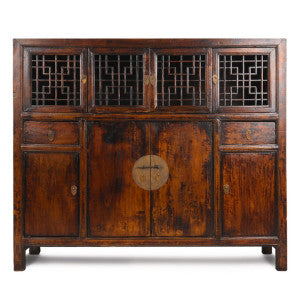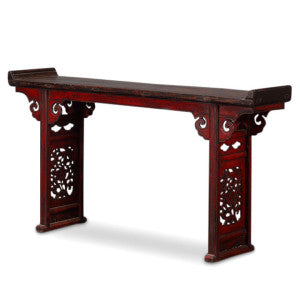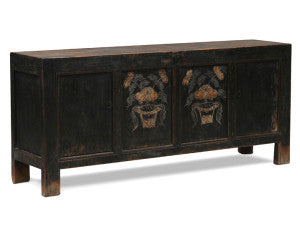
Eagerly awaiting our next container of Chinese antiques
We will be taking delivery of another container of Chinese antique furniture from Beijing in a couple of weeks from now and we can’t wait to get hold of the new pieces. You can already see and order the vast majority of these on our website, so I thought this would be a good time to pick out one or two of our favourites, along with others in our current collection.
| We are often asked by customers to find Chinese altar tables that would fit into a modern home as a console. They make fantastic focal points and display surfaces for family photos and ornaments and, with their upward turning flanges, are highly distinctive. The issue is often the size of the tables. Traditionally used in the main reception room of a Chinese home for use as a shrine to ancestors, most altar tables were sized at well over two metres in length – not always practical in a western home. These days it is becoming harder to find even larger antique altar tables in good condition, let alone ones with more manageable dimensions. |
|
The altar table shown here and currently sailing over from China is shorter than most similar pieces at around six foot long, with narrow proportions that would be ideal for a hall or living room. It comes from Shanxi province in central China and shows many features that are so typical of this type of table. The everted flanges are evident, as are the recessed legs that show beautiful open carvings of flowers, both inside and out. The legs are topped with symmetrical ‘cloud head’ spandrels to the front and back. The dark brown finish on the table top is original, whilst the deep red lacquer on the legs and apron appears to have been added more recently.
|
Painted Black Sideboard, Gansu |
With similar proportions but very different in style is a large sideboard in its original, now faded black finish and with paintings on the central doors. Although it was also sourced from Shanxi province, its early life would have been very different from the altar table. Rather than being a valued piece of furniture used for religious purposes, this solid, thick framed chest would have stored foodstuffs such as grain or flour. It would have opened through a removable plank in the top, since sealed, and what have now been converted into four doors would have been fixed panels. |
The matching decorative paintings of flower vases on the central doors originally would have been in bright, vibrant colours – greens, golds and oranges that would have contrasted beautifully against the deeper black lacquer. Now faded into more muted colours, the paintings still add a character and focus to an otherwise very simple design. This is a lovely example of a practical, vernacular item of furniture that has been recycled and repurposed for the modern day – in this case an unusual, very striking sideboard that would suit a dining room or reception area.
| Very different in style but similar in that it has been heavily adapted to create a more practical item of furniture is a low sideboard in blue lacquer. This cabinet was sourced from Qinghai province in western China and, in its original form, would have been typical of furniture from that region. Unsurprisingly, the distressed blue lacquer which adds a bright, fresh feel is new. This has been applied over the old, worn red which is still visible underneath in a few areas. Blue just wasn’t a colour used for furniture in China, being either unavailable as a pigment or unpopular, and in Qinghai cabinets like this it would almost always be in a rich red, created using a cinnabar pigment. |
|
 Elm Storage Cabinet, Shanxi Elm Storage Cabinet, Shanxi |
Perhaps less obviously, the larger doors to the right and left would originally have been fixed panels, the storage space behind them accessed only through the much smaller central doors. This seems an odd, highly impractical design to the modern furniture buyer but was far from uncommon in Qinghai cabinets one or two hundred years ago. The idea behind the design was that, at a time when modern locks weren’t available, it would make life difficult for any potential thieves looking to get their hands on the valuable items held inside. The carved apron and side spandrels, which taper down to the feet from an extended top, add a fluidity and elegance to what was a fairly provincial piece and, with the recent adaptations, the cabinet now would make a wonderful TV stand. |
Lastly, we absolutely love the large elm cabinet from Shanxi province shown above. The style, with open panels in the upper doors decorated with lattice work, suggests that its original purpose was to store food and it would make a stunning kitchen or dining room cabinet today used to store cutlery and crockery. The old dark lacquer finish has mellowed to leave soft, rich brown tones and a beautiful patina. The hardware is new, a replacement for the original that has been lost over the years and, as with the Qinghai cabinet, the two outer doors have most likely been added recently, but this is a lovely, unusual cabinet that is definitely one of our current favourites.
These four pieces should be arriving with us on the 17th July, along with another eighty or so other antiques, plus pottery, stoneware and other accessories. If you would like to see the latest collection then pay us a visit at our West Yorkshire showroom for a coffee and a browse. We look forward to seeing you.


 Red Lacquer Altar Table, Shanxi
Red Lacquer Altar Table, Shanxi
 Blue Lacquer Low Sideboard, Qinghai
Blue Lacquer Low Sideboard, Qinghai


Leave a comment